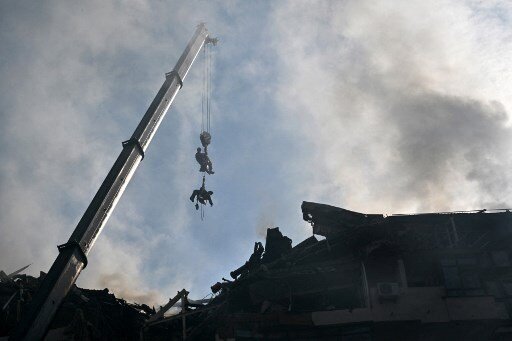Two air-to-ground missiles launched by Russian Federation (RF) Tu-22M bombers hit Odesa civilian infrastructure in a June 27 strike, a statement from Ukraine’s Joint Forces South (JFS) said. Six persons were injured, including one child, a statement from the Odesa City Council said.
Previous RF missile strikes against the Black Sea port city include a June 21 Bastion missile hitting in the vicinity of Odesa’s Artsyz airfield, and April 23 long-range munitions detonations in two Odesa apartment buildings, killing eight.
The Monday morning Odesa strike was the latest in a wave of new long-range RF attacks, including at least 48 long-range missiles striking targets across Ukraine on Saturday, and a Sunday missile strike against a residential district of the capital Kyiv.
Kyiv mayor Vitaly Klitschko in a statement on June 27 said a Russian national living in the capital’s Shevchenko district was injured and hospitalized, after the missile demolished the top two floors of the apartment building she lived in. Her husband, a Ukrainian national, was killed.
Zelensky in a Sunday evening television address said: “Firstly, all pilots, dispatchers, technicians and other people who take part in missile launches in Ukraine must understand: we will find you all, each of you will be responsible for these strikes…When your missiles hit residential buildings, these are war crimes. A trial is what awaits you all. And you will not hide anywhere – neither on the shores of the Caspian Sea, over which your missiles are launched, nor in Belarus … nowhere.”
Ukraine’s Army General Staff (AGS), in situation estimates made public on Saturday and Sunday, said the Kremlin used a combination of slow-moving cruise missiles, air-launched hypersonic missiles and high-trajectory ballistic missiles in the attacks. According to military observers, some were obsolete Soviet-era weapons incapable of precision strikes, and often unable to hit closer than a half kilometer to their intended targets.
According to the AGS Monday morning situation estimate, ground combat across most of the 2,500 kilometer fighting line had mostly stalled, with Ukraine Armed Forces (UAF) standing fast in defensive positions and RF units conducting artillery bombardments across the front, and making limited ground attacks in narrow sectors.
In the heavily fought-over Severodonetsk sector, the Kremlin primarily was using artillery fire and air strikes in an attempt to cut UAF supplies to the Ukraine-held town Lysychansk. Two RF ground attacks, against the outlying villages Vovchoyarivka and Verkhnyokamyanka, were repelled with losses, the report said.
According to the pro-Russia news platform Readovka, RF artillery fire had fully halted UAF supply to Lysychansk. At Voychoyarivka, RF units beat back a UAF attack, the news agency said.
Another RF ground attack, according to Ukrainian sources, was to the north-west of the city of Slovyansk, where UAF forces on the morning of Monday, June 27 engaged RF units attacking the village of Mezenivka, and fighting reportedly was still in progress by midday. According to Readovka, in the Slovyansk sector, no fighting took place aside from minor exchanges of artillery fire.
The UNIAN news agency on Monday, citing Ukrainian army intelligence, reported that trains loaded with ammunition were spotted travelling from Belarusian munitions depots to RF forces fighting in Donbas. According to Sunday’s Institute of Study of War (ISW) situation estimate, the Kremlin’s strategy for capturing the Donbas region is massive use of artillery against thinly-stretched UAF units. The UAF has attempted to interdict RF artillery ammunition deliveries, but in recent days RF artillery fire volumes have increased by as much as 50%, the ISW statement said.
Source:kyivpost.com/ukraine
